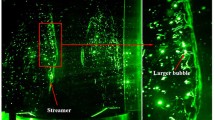We have investigated the specific features of excitation and formation of cavitation zones in ultrasound fields with a sound power density of up to 37 W/cm2 generated by a rod radiator with a power consumption of up to 5 kW. The influence of hydrodynamical flows generated in a liquid medium by the rod waveguide itself on the formation and characteristics of cavitation zones in an intense ultrasound field has been considered for the first time. The possibility of increasing the physical activity of cavitation by introducing activating additives into the medium has been explored. On the basis of the investigations made, proposals have been formulated for increasing significantly the cavitation zone activity and the efficiency of cavitation treatment of media and materials.
Similar content being viewed by others
References
B. Carlin, Ultrasound [Russian translation], IL, Moscow (1950).
L. Bergman, Ultrasound and Its Application in Science and Industry [Russian translation], IL, Moscow (1956).
W. P. Mason (Ed.), Physical Acoustics, Vol. 1. Principles and Methods [Russian translation], Mir, Moscow (1967).
L. D. Rozenberg, Powerful Ultrasonic Fields [Russian translation], Nauka, Moscow (1968).
I. E. Él′piner, Ultrasound: Physicochemical and Biological Action [in Russian], Fizmatgiz, Moscow (1963).
M. A. Margulis, Principles of the Sound Chemistry [in Russian], Vysshaya Shkola, Moscow (1984).
M. A. Margulis, Sonoluminescence, Usp. Fiz. Nauk, 170, No. 3, 263–287 (2000).
B. G. Novitskii, Application of Acoustic Vibrations in Chemical–Technological Processes [in Russian], Khimiya, Moscow (1983).
B. I. Bakhtin, A. V. Desyatov, A. P. Kubyshkin, and A. S. Skorokhodov, Features of cavitation and cavitation erosion of the waveguides of powerful ultrasonic units at a high pressure of the medium, Inzh.-Fiz. Zh., 81, No. 4, 690–695 (2008).
B. I. Bakhtin, A. V. Desyatov, O. I. Korba, A. P. Kubyshkin, and A. S. Skorokhodov, Low-temperature cracking of hydrocarbons in cavitation ultrasound fi elds, Mir. Nefteprod., No. 6, 14–18 (2009).
Y. Matsumoto, Micro bubble and bubble cluster dynamics in ultrasound fi eld, in: Proc. 16th Int. Symp. on Nonlinear Acoustic ISNA 16, 19–23 August, 2002, Moscow State University, Vol. 2, pp. 963–970.
E. A. Bushmanov, V. Yu. Velikodnyi, V. P. Vorotilin, I. B. Timofeev, Yu. G. Yanovskii, and D. Van Vi, On the possibility of upgrading the characteristics of activated porous fuel by using ionization processes in a dielectric cavitator, Prikl. Fiz., No. 5, 49–54 (2003).
V. G. Kozlov, Experimental Investigation of the Averaged Vibrational Dynamics of an Incompressible Fluid, Doctoral Dissertation (in Physics and Mathematics), Permsk. Gos. Univ., Perm′ (1997).
A. Moussatov, C. Grenger, and B. Dubus, Characterization of cavitation fi eld in ultrasonic reactor, in: Proc. 16th Int. Symp. on Nonlinear Acoustic ISNA 16, Moscow State University, 19–23 August, 2002, Vol. 2, pp. 1023–1026.
V. N. Skokov, V. P. Koverda, A. V. Reshetnikov, and A. V. Vinogradov, Critical behavior in cavitation of liquids in an ultrasound field, Ext. Abstr. 4th Russian Nat. Heat Mass Transfer Conf., October 23–27, 2006.
G. I. Kuvshinov and P. P. Prokhorenko, Acoustic Cavitation near Solid Surfaces [in Russian], Navuka i Tékhnika, Minsk (1990).
K. Pris, Erosion [Russian translation], Mir, Moscow (1982).
Author information
Authors and Affiliations
Corresponding author
Additional information
Translated from Inzhenerno-Fizicheskii Zhurnal, Vol. 87, No. 3, pp. 650–663, May–June, 2014.
Rights and permissions
About this article
Cite this article
Bakhtin, B.I., Ivashov, A.I., Kuznetsov, A.V. et al. Experimental Investigation of the Specific Features of Formation of Cavitation Zones in Intense Ultrasound Fields. J Eng Phys Thermophy 87, 672–685 (2014). https://doi.org/10.1007/s10891-014-1059-4
Received:
Published:
Issue Date:
DOI: https://doi.org/10.1007/s10891-014-1059-4




